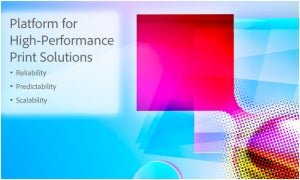http://blogs.adobe.com/conversations/files/2013/09/PDF-Print-Engine.png
Adobe today announces Adobe® PDF Print Engine 3, the next-generation rendering platform, optimized for end-to-end print workflows based on Adobe Portable Document Format (PDF). Adobe PDF Print Engine 3 combines performance enhancements with a new scalable architecture to power the industry’s fastest digital presses, large format printers, and platesetters. Print Service Providers (PSPs), print OEM solution providers, and designers will find that Adobe PDF Print Engine 3 is the most powerful rendering platform for reliable reproduction of complex, graphically-rich content.
Adobe PDF Print Engine 3 can be configured with the new Mercury RIP Architecture – a scalable, parallel-processing framework for extending RIP horsepower and dynamically balancing processing loads across available hardware. The Mercury RIP Architecture was designed to drive the high-speed digital presses of today . . . and tomorrow. In particular, it excels in Variable Data Printing (VDP). Recent testing at Adobe demonstrated that PDF Print Engine 3 with the Mercury RIP Architecture is the fastest rendering technology in the industry today.
Several long-standing OEM partners are working to harness the Mercury RIP Architecture in upcoming solutions. For example, Fujifilm today announced XMF 5.5 for the JetPress 540W, built on the Mercury RIP Architecture. In the coming weeks and months we expect to see new product announcements highlighting support for the Mercury RIP Architecture from a number of market-leaders, including Canon Production Systems, EFI, Kodak NexPress, Screen and Xeikon.
- “One of the reasons Fiery is the gold standard of the graphics arts industry is because of our partnership with Adobe,” says Toby Weiss, EFI senior vice president and general manager of the Fiery Division. “Providing seamless integration with Creative Cloud and supporting the new Mercury RIP Architecture provide extreme value to our clients and partners.”
- “NexPress**** was the first digital press to be driven by the Adobe PDF Print Engine”, says David Dellert, chief software engineer for Kodak. “Now, with version 3, we will be integrating the Mercury RIP Architecture into our product line, to meet the ever increasing demands of the digital print business.”
- “Xeikon plans to deploy the Mercury RIP Architecture in our X-800 line”, says Jeroen Van Bauwel, director of product management for Xeikon. “Since the speed of our presses will continue to increase, scalability is central to our product strategy.”
Adobe PDF Print Engine 3 is aligned with the Adobe Creative Cloud, including applications such as InDesign, Illustrator, Photoshop and Acrobat. As a result, the most complex, high-impact graphics, designed with the latest authoring tools, will be accurately reproduced on-press.
What’s new in Adobe PDF Print Engine 3? Here are the top three, and their user benefits.
- The Mercury RIP Architecture for the Adobe PDF Print Engine 3, manages multiple concurrent instances of the Print Engine for maximum throughput within a single system, or several systems on a network. It is able to dynamically load balance available work across multiple presses concurrently, ensuring full resource utilization.
- Adobe PDF Print Engine 3 can support continuously streamed PDF and PDF/VT in High Volume workflows, (such as HVTO and Transpromo), fast-growing segments of the print industry.
- Adobe PDF Print Engine 3 renders content which matches the display in Reader and Acrobat XI. Using the same core Adobe PDF technology at every stage of the print workflow ensures predictability and eliminates unwelcome surprises.
“With PDF Print Engine 3, Adobe continues to demonstrate our leadership in print – 30 years after launching PostScript and igniting the Desktop Publishing revolution. Faster processing and greater predictability translate directly into higher profits for our partners’ customers: the printers of the world,” says Naresh Gupta, senior vice president of Adobe’s Print and Publishing Business Unit.
Today’s announcement represents the continuing evolution of the Print Engine SDK, launched in 2006. Initially adopted by vendors in traditional offset printing, there are currently more than 90,000 units in live production around the globe. In the past three years, the technology has been embraced by market-leading vendors in Digital Production Printing (DPP) and Large Format Printing (LFP).
PDF Print Engine 3 replaces Adobe PDF Print Engine versions 2.5 and 2.6. PSPs and global print OEMs can learn more about PDF Print Engine 3 here.
– Mark Lewiecki, senior product manager, Adobe
